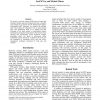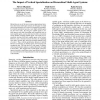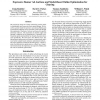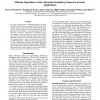AAAI
2008
14 years 2 months ago
2008
We have spelling and grammar checking tools available on today's word processors. But what they are missing is a tool that can recommend several possibilities of a given writ...
AAAI
2008
14 years 2 months ago
2008
We present a real-time strategy (RTS) game AI agent that integrates multiple specialist components to play a complete game. Based on an analysis of how skilled human players conce...
AAAI
2008
14 years 2 months ago
2008
The recent years have witnessed a surge of interests in semi-supervised learning methods. A common strategy for these algorithms is to require that the predicted data labels shoul...
AAAI
2008
14 years 2 months ago
2008
A recurring theme in AI and multiagent systems is how to select the "most desirable" elements given a binary dominance relation on a set of alternatives. Schwartz's...
AAAI
2008
14 years 2 months ago
2008
In this paper, a bottom-up hierarchical genetic algorithm is proposed to visualize clustered data into a planar graph. To achieve global optimization by accelerating local optimiz...
AAAI
2008
14 years 2 months ago
2008
Hierarchies are one of the most common organizational structures observed in multi-agent systems. In this paper we study vertical specialization as a reason for hierarchical struc...
AAAI
2008
14 years 2 months ago
2008
This paper presents a fast simulated annealing framework for combining multiple clusterings (i.e. clustering ensemble) based on some measures of agreement between partitions, whic...
AAAI
2008
14 years 2 months ago
2008
We present the design of a banner advertising auction which is considerably more expressive than current designs. We describe a general model of expressive ad contracts/bidding an...
AAAI
2008
14 years 2 months ago
2008
In a class of games known as Stackelberg games, one agent (the leader) must commit to a strategy that can be observed by the other agent (the adversary/follower) before the advers...
AAAI
2008
14 years 2 months ago
2008
Direction relations between extended spatial objects are important commonsense knowledge. Recently, Goyal and Egenhofer proposed a formal model, called Cardinal Direction Calculus...




